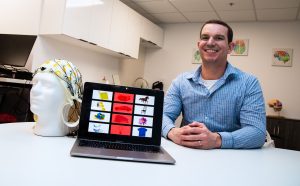
For children with severe speech and physical impairments (SSPI), the inability to share their thoughts and feelings can deeply affect their quality of life and well-being.
Researchers and engineers continue to seek new ways to help these children communicate, including an experimental technology that enables thoughts to control communication devices, known as communication brain-computer interfaces (cBCIs).
Since launching the project in 2023, Kevin Pitt, assistant professor of special education and communication disorders, has seen promising results using BCI tools designed to support children.
Pitt and his team are working to ensure these cBCI tools are developed with children’s input at every step to make the devices engaging and user-friendly.
“When you think about communication devices with children, a lot of training and intervention happens,” said Pitt, a CYFS research affiliate. “But with this study, we’re looking at starting performance and not providing any training yet, as will be the case in the future. So these early results are encouraging.”
I’ve been surprised by the amount of positive feedback that we’ve had from both kids and their parents. It’s good to know they enjoy coming in to help us with our research.”
— Kevin Pitt, assistant professor of special education and communication disorders
Funded by the National Institutes of Health, the ongoing project uses data from a 2022 pilot study of adults with SSPIs. Pitt tailored his research to focus on children by integrating BCI tools with augmentative and alternative communications (AAC) devices used with pediatric patients, including picture-based communication boards that may be used on different tablet-based communication apps.
Pitt is using the P300 cBCI device — a communication tool that records brain activity through electrodes in a non-invasive cap. Typically, the user views a P300-cBCI screen showing different flashing letters. The cBCI detects which letter the user is focused on, enabling the system to learn what the user wants to select.
In this study, Pitt aims to shift cBCI to children by having participants view pictures instead of letters. He will explore children’s style preferences using an interactive, tablet-based app developed in his lab.
Preliminary results show children strongly prefer animated effects when using the tool, such as flashing items on the screen using zoom effects, animated GIFs and fun images such as animals or cartoon characters.
“Animation, personalization and color selection in the design appears to improve user engagement and are preferred features for cBCI design,” Pitt said. “Instead of something on the screen being highlighted in red, it kind of zooms out right toward them. Or sometimes they use animated GIFs of characters, such as Minions. That’s been one of the themes that’s really come out so far.”

Participants include 40 typically developing children and 10 children, ages 8-12, diagnosed with cerebral palsy or Duchenne muscular dystrophy. Each child is tested at the Augmentative and Alternative Communication (AAC) Translation Lab, where they participate in two P300 cBCI sessions and a final session using the iPad application to design their preferred cBCI display. Tasks involve simple games, such as tic-tac-toe, to track cBCI accuracy.
Pitt and his team have finished testing seven children diagnosed with cerebral palsy or Duchenne muscular dystrophy and are recruiting three more.
“Working with the participants has been the best thing about the project,” Pitt said. “I’ve been surprised by the amount of positive feedback that we’ve had from both kids and their parents. It’s good to know they enjoy coming in to help us with our research.”
Based on children’s feedback, Pitt is working with a group in Canada to develop a new BCI system that incorporates motion into the existing P300 cBCI software. He aims to build a test the motion cBCI device in 2026.
Learn more about this project in the CYFS Research Network.
